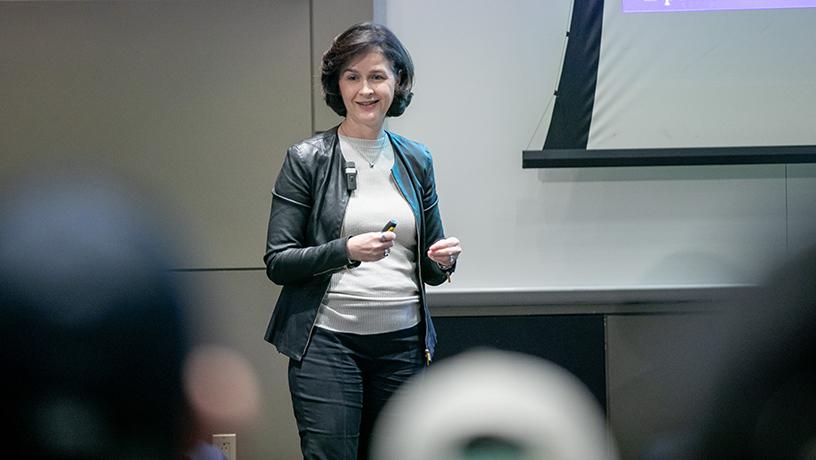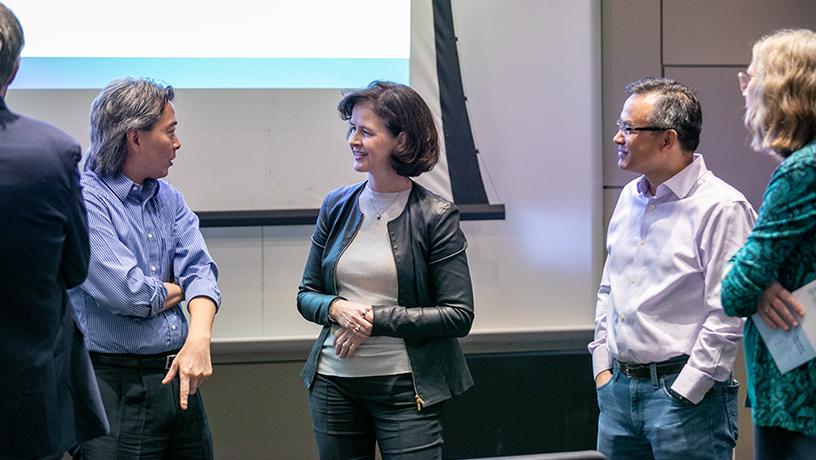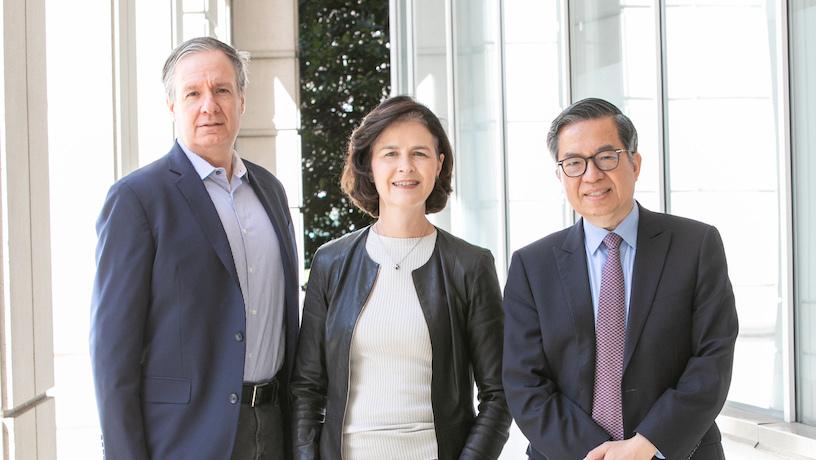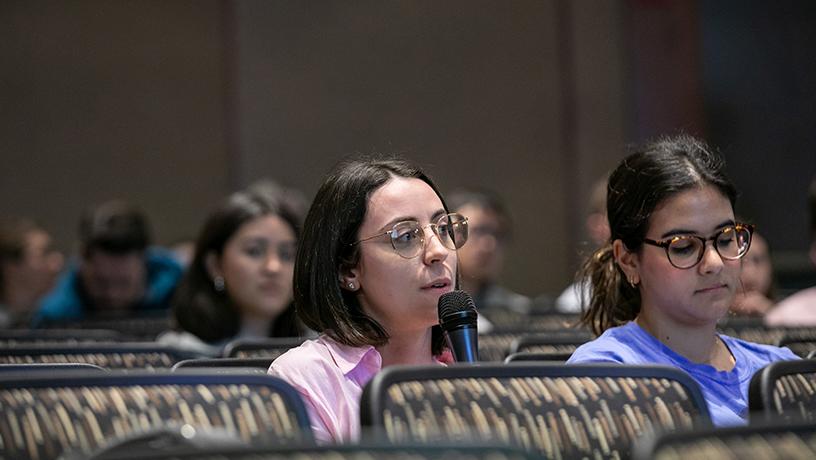Exponent CEO Catherine Corrigan Shares Insights on the Biomechanics of Injury
The biomechanics expert took students through a real-world case study as part of the Columbia Engineering Tech CEO Lecture Series and Richard Skalak Distinguished Lecture in Bioengineering
Pioneering executives share their insights as part of the Tech CEO Lecture Series

Catherine Corrigan, Exponent president and CEO
On March 8, powerhouse Catherine Corrigan, president and CEO at Exponent, visited campus to give the 2024 Richard Skalak Distinguished Lecture in Bioengineering, an event that was also the latest installment in Columbia Engineering’s ongoing Tech CEO Lecture Series.
Held in Davis Auditorium at Columbia’s Morningside Heights campus, Corrigan shared her insights and expertise in injury biomechanics and engineering’s role in the field.
Corrigan has dedicated her professional career to Exponent since completing her doctoral studies at MIT in 1996. Her research focuses on the biomechanics of human injury, with expertise in orthopedic biomechanics and a focus on applying her research expertise to clients’ real-world challenges across sectors like transportation, life sciences and healthcare, construction, and energy. At Exponent, where Corrigan was appointed president in 2016 and CEO in 2018, she has consulted on issues related to motor vehicle and product safety for more than 20 years.
"I am thrilled about Catherine's participation in this talk. Exponent's commitment to a multidisciplinary approach to solving complex issues aligns perfectly with our school's vision," said Shih-Fu Chang, Dean of Columbia Engineering in introductory remarks. The emphasis on multidisciplinary themes is a hallmark of how Columbia Engineering approaches education. In addition to establishing a solid foundation in engineering fundamentals, students also get to learn social science, humanities, and how to leverage engineering expertise to address diverse and complex issues.
Founded in 1967, Exponent is an engineering and scientific consulting firm with a multidisciplinary team of scientists, physicians, engineers, and business consultants. They tackle complex challenges in product analysis, regulatory compliance, research and development, and forensic investigations. They have played a crucial role in the investigation of high-profile cases like the 1974 Turkish Airlines crash, the World Trade Center collapse analysis, and Superstorm Sandy recovery efforts.

Catherine Corrigan chats with Columbia Engineering faculty who attended the March 8 lecture.
The study of injury biomechanics
At the center of her talk, Corrigan provided everyday examples of biomechanics, such as the mechanics of lifting a box and calculating the force. She explained that biomechanics blends biology and engineering, studied at multiple levels: cellular, tissue, organ, and whole body. By applying the mechanics to practical applications, this multidisciplinary approach helps us better understand our bodies’ responses to various forces, she said. Among all the responses, injury is a particular focus. As one practical branch of biomechanics, injury biomechanics research offers an understanding of injuries at various levels. Researchers apply engineering principles to analyze how injuries are made and work on strategies for prevention and treatment. "The study of injury biomechanics is important for understanding what has happened—identifying what is injured and how, as well as what remains uninjured, and why," said Corrigan to an audience of primarily students, researchers, and faculty.

Catherine Corrigan pictured with Paul Sajda (left), Chair of the Department of Biomedical Engineering, and Shih-Fu Chang (right), Dean of Columbia Engineering
Informing safer product design and development
Ultimately, the goal of injury biomechanics is the prevention of injury. When it comes to real-world analysis, injury biomechanics informs safer product design and development. "We rely on accident data, which is uncontrollable. This leads us to non-injurious testing. If I apply force to someone and they don't get hurt, it gives us clues about tolerance," said Corrigan.
Corrigan presented a case study on an automotive rollover accident to show how scientists and engineers employ biomechanical analysis to understand injury mechanisms. The case involved a vehicle that, after a collision, went over a guardrail and rolled down a hill.
The team first mapped the injuries and conducted a series of analyses. They then used simulations to recreate the accident. They utilized high-speed cameras to capture the footage, and calculated head accelerations and neck forces. After thorough analysis, one key recommendation was strengthening the car roofs.
“This case is to highlight how data and lab tests are applied to understand injury mechanisms. Such analyses help us evaluate the effectiveness of mitigation strategies, like how to lower the risks,” Corrigan said.

Students and attendees during the Q-and-A session of Corrigan’s lecture
Computational modeling shapes the future of biomechanical research
During the Q-and-A session with the audience, Corrigan discussed the significant impact of computational modeling and simulation tools on today’s biomechanics field. "We absolutely use simulation tools as part of our analysis. Although not in every case, as computational power and the sophistication of the tools increases, there are many more opportunities to use dynamic models and multi-segment models," Corrigan said.
Corrigan, who was elected as a member of the National Academy of Engineering in 2021, emphasized Exponent’s dedication to advancing biomechanics research. “We really pride ourselves on coming up with novel test methodologies, even though they aren't standard yet to answer the questions,” Corrigan said. “Keeping up on what the latest methodologies are in the context of the incidents, this is part of the secret sauce that we bring to the equation.”
About the Tech CEO series
Columbia Engineering’s Tech CEO Lecture Series offers students insights into the latest industry trends and developments. The series kicked off last September with a lecture by Benoit Bazin, CEO of Saint-Gobain, on Sustainable Construction. Following him, Rajesh Jain, founder of Netcore Cloud and a Columbia Engineering alumnus shared his entrepreneurial lessons.
This Tech CEO installment featuring Catherine Corrigan was also part of the Richard Skalak Distinguished Lecture in Bioengineering, established by Columbia's Department of Biomedical Engineering in 1996. The lecture’s namesake honors Richard Skalak, a Columbia alumnus and biomechanics pioneer, and the program welcomes distinguished speakers to discuss their impact and progress in bioengineering.
View Catherine Corrigan's full lecture
